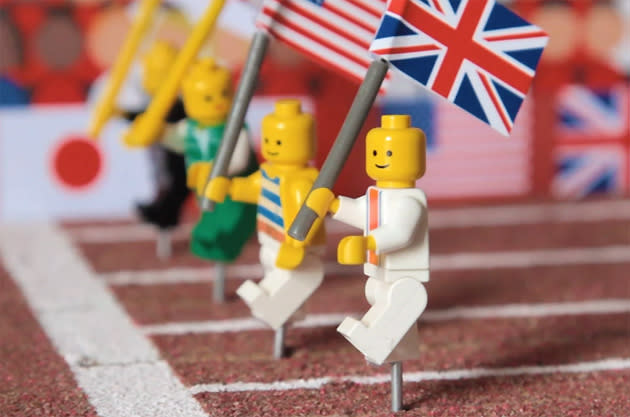LEGO, Twitter and one inventor’s Olympic experiment: Presenting The Digilympics

LONDON — The athletes stand shoulder-to-shoulder at the starting line, each representing their nations in Olympic competition. The American runner sprints out first, the Canadian on his heels.
Suddenly, the British track star smokes his foes to the finish line ... an impressive feat, considering his legs are a few millimeters long and there's a metal rod protruding from the bottom of one of them.
Even stranger, his victory was entirely owed to the power of Twitter.
Welcome to the Digilympics.
[ Related: U.S. hurdler tweets about lost London bus driver ]
Samuel Cox is a U.K. "hardware hacker" who saw the London Olympics as an opportunity to explore "the social/physical side of Twitter and how it can engage an online community," he said.
"Twitter is a great platform for sharing content, but there's becoming a new use for it. It turns out that it's a great tool for allowing anyone to create physical, real-life interactions — and anyone can take part regardless of your location."
Cox's invention: Taking LEGO figures that represent the USA, U.K., Canada and Japan, placing them on an automated motor, and linking that motor with a computer program that powers each runner using one of four unique Twitter accounts (UK_Digi, US_Digi, CA_Digi & JP_Digi). Send a message to @US_Digi, and the USA "runner" moves up on the track.
It's like Version 2.0 of a carnival game: Rolling rubber balls into holes with numerical values to power a race horse, or firing a water cannon into a clown's mouth to fill a balloon past its capacity. Only without the sticky cotton-candy covered fingers. (Unless that's how you roll on social media; we're not here to judge.)
The first race began on July 18, and will continue for two weeks. The races are due to be streamed live at digilympics.com and standings will be updated on July 25.
Based on the Twitter action thus far, the Digilympics are off to a slow start, but Cox is happy with the interest in his blockheads' races. "The reaction towards the Digilympics has been great. What people like is that they can send a simple tweet and it has a physical real world reaction, like it's making a solid difference," he said.
Here's a look:
The Digilympics from Sam Cox on Vimeo.
How does it work? From Cox:
A Processing sketch scans the Twitter account of each country for any '@' replies. Any new replies are passed to an Arduino (open-source single-board microcontroller) with four motors attached, one for each team. The motors spin and advance each team forward in response to tweets received. An infra-red beam detects the country reaching the finishing line first and signals for the reset of a new race.
"The biggest technical challenge involved all the coding behind it," he said. "Getting an automated system in place that scans Twitter 24/7 and advances the LEGO men forward was a little tricky. Once that was tuned the physical build was relatively simple, just another weekend."
Cox said he learned how to "open up" Twitter through creative coding in making the Digilympics. But what could it mean for the future of social media and automated entertainment?
Are we at the dawn of Twitter-controlled robo-athletes?
"I don't think the idea of influencing virtual or AI athletes is far-fetched at all," said Cox. "Maybe it'll be the next revolution in the Games, coming to your sofa in 2020."
Memorable Moments Countdown #3 from Yahoo! Sports:
Other popular Olympics content on Yahoo! Sports:
• Theater shooting hits close to home for Colorado Olympians
• Pistorius blasts critics over Games place
• Video: Will Phelps or Lochte be the bigger star?

 Yahoo Sports
Yahoo Sports 
